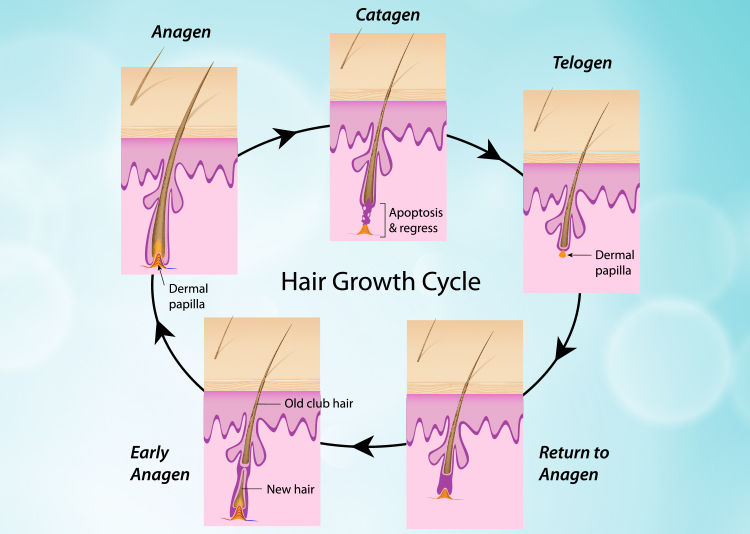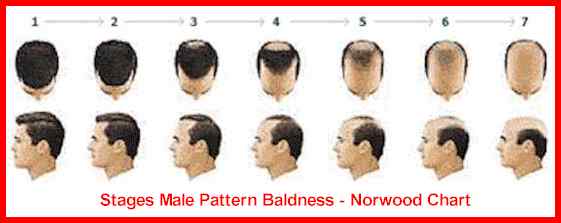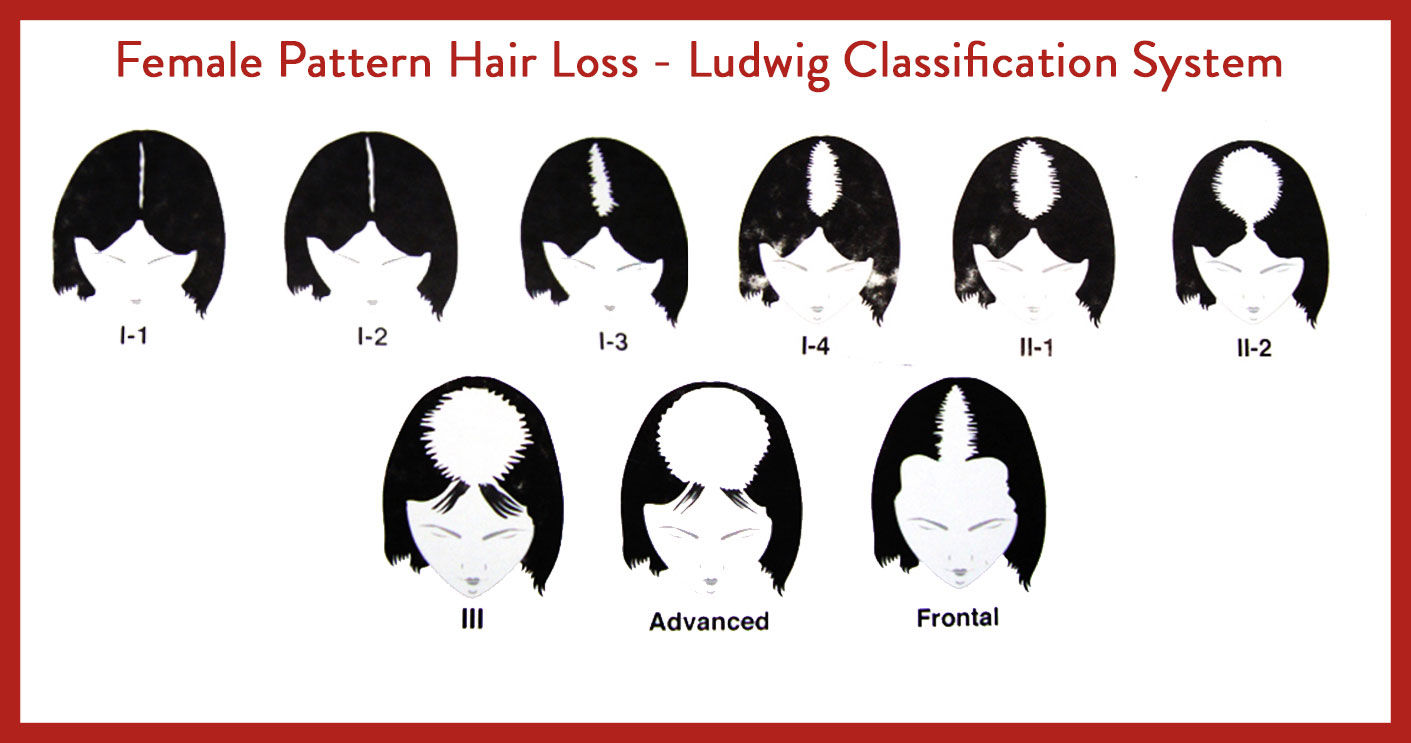Hair grows from the follicle or hair root, underneath the skin. The hair is nourished by the blood vessels at the base of the follicle, which gives the needed nutrition to the roots to grow. There are four stages of hair growth cycle from the starting phase till falling, which introduces the life cycle of the hairs. The four stages of hair growth cycle are the Anagen known as growing phase, Catagen, a regression phase, Telogen, it is a resting phase and the Exogen is a shedding phase. Every hair keeps switching over to the next stage of the growth cycle. After the Anagen (growing) phase of the hair growth cycle is complete, the hair follicle enters into the Catagen (transition) phase of the hair growth cycle, in which the hair follicle shrinks and separates from the root. The Telogen phase lasts around 3 months. Around 10-15% of hairs are in this phase. If the hair enters in resting phase, too early it will be notified that hair starts shedding results in the thinning and loss of hairs on the scalp. The Exogen phase represents the detaching of hair roots when they reached the terminal position in the follicles and the resting hair is gradually loosened resulting in shedding of the hair. Over the time, the length of the Anagen stage decreases. However, the hair may become weaker and thinner after each cycle. That is why it is important to ensure that the nutrient-rich diet is required in order to maintain a strong and healthy hair growth.

Hair Growth Cycle
Hair strings on the pillow in the morning, strands of hair in the bathtubs during the shower, tangled hair strands in the comb, fallen hairs on the shoulder are not alarming. It is a normal hair shedding. Out of the total hair on the head, 85% to 90% are in a growing phase. The other 10% to 15% are in the resting phase. This suggests that it will shed to give the place for new hair growth. This normal hair shedding is generally a temporary loss unless there will not be any cause of conditional or a permanent factor of a genetic cause for hair loss.
Male Pattern Baldness (MPB) is a genetic dysfunction of genes that transfer from one generation to other either the paternal or the maternal sides causes the genetic hair loss/baldness known as Androgenic alopecia. Androgenic alopecia is a condition caused by the hormonal DHT (Di-hydro Testosterone) sensitivity activities that occur after the synthesis of DHT by the enzyme called 5-alpha reductase from testosterone. The DHT, attacks on the hair follicles causes the shrinking of hair over the time as a result of Miniaturization effect, a form of the hair loss due to the over sensitivity of it! The miniaturization appears as a shrinking of follicles, thinning of hair that eventually falls out for permanently.

Miniaturization of hair with the effect of DHT
Some men become very bald and the affected area is mostly on the top of the head. Typically, male pattern baldness starts from the forehead and vertex part of the scalp. It progresses gradually and creates a rim (band) of hair at the back and sides of the head.
MPB can easily be identified without having any clinical experience. It only affects hair on the top of the scalp and not the sides, presents a horseshoe-shaped pattern in the areas of hair loss. There are the different forms of common patterns of hair loss, i.e., a receding hairline, thinning crown or general thinning spread all over the top area of the head.

Genetic or Androgenic Alopecia (Male Pattern Baldness)
MPB never affects the sides or back of the hair and that is why this zone treated as a donor area during the hair transplant procedure. Dr Suneet Soni gives the kind consideration to the role of safe donor portion and that is why he prefers the FUT hair transplant, mostly, which takes the hair grafts from the back and sides of the scalp (Donor zone) results in long-lasting hair roots as these hair roots are resistant to the effect of DHT (di-hydro Testosterone). Dr Suneet Soni is well-versed in performing the FUT, FUE and the combination method of FUT+FUE, Giga/Mega sessions with the remarkable results.
Around 1/3rd of women experience a hair loss to some extent in their lives. More than 2/3rd of females suffer from bald spots as an effect of the genetic causes. Hair loss creates greater influence on women than on men because it is not socially acceptable for them. Alopecia can affect a woman’s emotional status and a plays a factor for mental agony in her life. If we try to understand the causative factor for the Alopecia, we will find that every strand of hair rests in a tiny hole in the skin called a follicle. Commonly, baldness occurs when the hair follicle starts shrinking over the time. At last, the follicle does not produce new hair and hair growth is a state of ultimate hair loss.

Female Pattern of Hair Loss
When the follicles are healthy and viable, it indicates that there is the possibility of further hair growth. The reason for female pattern baldness that may relate to the women’s age, hormonal changes, family history, excessive use of chemical products, prolonged medications as well. Because of female pattern baldness (FPB), most of the women find that the hair is getting thinner day-by-day, while her facial hair is rougher.
In Female Pattern Baldness (FPB), hair thinning a bit different as compared to the Male Pattern Baldness (MPB). In FPB, Hair thins mainly on the top and crown of the scalp. Gradually, it widens through the central hair part. The Temporal hairline remains unaffected except for normal recession, which happens to everyone with the growing age. In FPB, the hair loss does not lead to the complete baldness but becomes thinner and due to the continuous hair fall makes the scalp visible. At Medispa Laser, Cosmetic & Hair Transplant Centre, Jaipur & New Delhi (India); Dr Suneet Soni has a record of giving the best aesthetic outcomes in the case of female hair transplant that can be seen from many reputed hair transplant forums and societies. The hair transplant in Jaipur is a cost-effective and when we talk about it in an Indian context, it plays a major role in choosing the best hair transplant clinic.
Several factors cause the hair loss, including the individual health conditions, medications, genetic imbalance, physical or psychological factor, and external factors of environmental pollution, polluted water, and chemotherapy as well. Men and women both equally suffer from the Androgenic alopecia. The Androgenic alopecia is genetically destined for the hair loss that presents the causes of shortening the Anagen phase, determined the growth of the hair and increases the time of the hair shedding as well as an increased interval for growing the new hair. However, it takes a longer time to start a new hair growth that must be started just after the shedding of the hair in the normal growth cycle of hair. The hair follicle itself changes, shrinks and produces a smaller and thinner hair shaft. This natural process called “follicular miniaturisation.” As a result, shorter, thinner, non-pigmented hairs called “vellus” replace the thicker, pigmented, long-lived “terminal” hairs. Hair transplantation, a procedure has been in use as a curative option since the 1950s. The procedure comprises detaching a strip of scalp from the back of the head and using it to fill in a bald patch. Today, 90% of hair transplant surgeons use a technique called follicular unit transplantation (FUT), invented in the field of hair restoration during the mid-1990s. During this procedure, surgeons remove a narrow strip of the scalp and divide it into the thousands of grafts, each graft contain small clusters of 1-4 follicles in numbers, known as a Follicular Units. Each graft is planted in a slit on the scalp. Transplanted hair grows naturally the way other hair grows.
In the context of cost, the cost of hair transplant in India is just one-fourth of the countries like the USA, UK and Europe and this is a major deciding factor among the patient/client, which turns them into our country. The prime city like the Jaipur & Kota (Rajasthan) as well as in Delhi is counted as the best option for the hair restoration procedure.


Hair transplant surgery aims to achieve a result that is as natural as possible. In order to do this, however, we need more than the most up to date techniques.